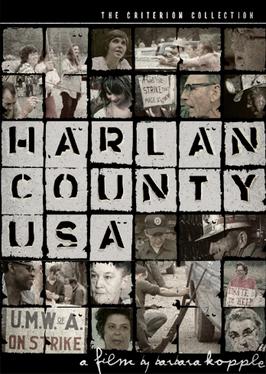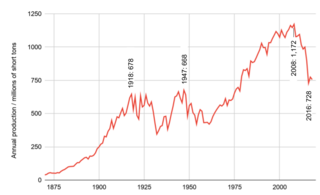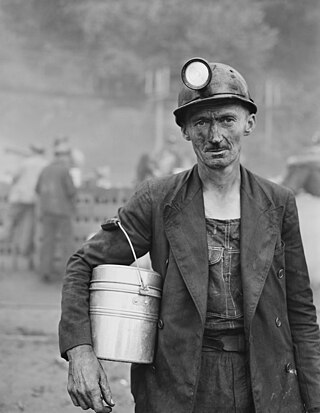Related Research Articles

Jenkins is a home rule-class city in Letcher County, Kentucky, United States. The population was 2,203 as of the 2010 census.

The United Mine Workers of America is a North American labor union best known for representing coal miners. Today, the Union also represents health care workers, truck drivers, manufacturing workers and public employees in the United States and Canada. Although its main focus has always been on workers and their rights, the UMW of today also advocates for better roads, schools, and universal health care. By 2014, coal mining had largely shifted to open pit mines in Wyoming, and there were only 60,000 active coal miners. The UMW was left with 35,000 members, of whom 20,000 were coal miners, chiefly in underground mines in Kentucky and West Virginia. However it was responsible for pensions and medical benefits for 40,000 retired miners, and for 50,000 spouses and dependents.

The Ludlow Massacre was a mass killing perpetrated by anti-striker militia during the Colorado Coalfield War. Soldiers from the Colorado National Guard and private guards employed by Colorado Fuel and Iron Company (CF&I) attacked a tent colony of roughly 1,200 striking coal miners and their families in Ludlow, Colorado, on April 20, 1914. Approximately 21 people were killed, including miners' wives and children. John D. Rockefeller Jr. was a part-owner of CF&I who had recently appeared before a United States congressional hearing on the strikes, and he was widely blamed for having orchestrated the massacre.

Harlan County, USA is a 1976 American documentary film covering the "Brookside Strike", a 1973 effort of 180 coal miners and their wives against the Duke Power Company-owned Eastover Coal Company's Brookside Mine and Prep Plant in Harlan County, southeast Kentucky. It won the Academy Award for Best Documentary at the 49th Academy Awards.
The Baldwin–Felts Detective Agency was a private detective agency in the United States from the early 1890s to 1937. The agency's members played a key role in the events that led to the Battle of Blair Mountain in 1921 and violent repression of labor union members. Significant incidents, later collectively known as the Coal Wars, occurred in various locations. The Pocahontas Coalfield region of West Virginia witnessed some of these events. Among these incidents are the Paint Creek–Cabin Creek strike of 1912 in West Virginia, 1913–1914 Colorado Coalfield War, and the Battle of Matewan in 1920.
The Battle of Matewan was a shootout in the town of Matewan in Mingo County and the Pocahontas Coalfield mining district, in southern West Virginia. It occurred on May 19, 1920 between local coal miners and their allies and the Baldwin–Felts Detective Agency. The dead included two brothers of the detective agency's founder and Matewan's mayor Cabell Testerman, who supported the union.

The Battle of Blair Mountain was the largest labor uprising in United States history and is the largest armed uprising since the American Civil War. The conflict occurred in Logan County, West Virginia, as part of the Coal Wars, a series of early-20th-century labor disputes in Appalachia.

The Paint Creek–Cabin Creek Strike, or the Paint Creek Mine War, was a confrontation between striking coal miners and coal operators in Kanawha County, West Virginia, centered on the area enclosed by two streams, Paint Creek and Cabin Creek.

The West Virginia coal wars (1912–1921), also known as the mine wars, arose out of a dispute between coal companies and miners.
Arnold Ray Miller was a miner and labor activist who served as president of the United Mine Workers of America (UMWA), AFL–CIO, from 1972 to 1979. Winning as a reform candidate, he gained positive changes for the miners, including compensation for black lung disease. He had difficulty dealing with growing internal union opposition. His last two years as president were particularly tumultuous and he suffered two heart attacks, finally resigning in November 1979 with the title of "president emeritus for life".

Frank J. Hayes was an American miner and president of the United Mine Workers of America (UMWA) from 1917 to 1919. A Democrat, he also served as Lieutenant Governor of Colorado in 1937–39.
Florence Reece was an American social activist, poet, and folksong writer. She is best known for the song "Which Side Are You On?" which she originally wrote at the age of twelve while her father was out on strike with other coal miners, according to The Penguin Book of American Folk Song by Alan Lomax.

The history of coal mining in the United States starts with the first commercial use in 1701, within the Manakin-Sabot area of Richmond, Virginia. Coal was the dominant power source in the late 1800s and early 1900s, and although in rapid decline it remains a significant source of energy in 2024.
The Pittston Coal strike was a United States strike action led by the United Mine Workers Union (UMWA) against the Pittston Coal Company, nationally headquartered in Pittston, Pennsylvania. The strike, which lasted from April 5, 1989 to February 20, 1990, resulted from Pittston's termination of health care benefits for approximately 1,500 retirees, widows, and disabled miners. The strikers also cited the refusal of the company to contribute to the benefit trust established in 1950 for miners who retired before 1974 and the refusal of the company to bargain in good faith as grounds for their action. The company cited declining coal prices, decreasing demand, and recession as its reason for limiting health care benefits.
Coal was discovered in Kentucky in 1750. Since the first commercial coal mine opened in 1820 coal has gained both economic importance and controversy regarding its environmental consequences. As of 2010 there were 442 operating coal mines in the state, and as of 2017 there were fewer than 4,000 underground coalminers.

The Colorado Coalfield War was a major labor uprising in the southern and central Colorado Front Range between September 1913 and December 1914. Striking began in late summer 1913, organized by the United Mine Workers of America (UMWA) against the Rockefeller-owned Colorado Fuel and Iron (CF&I) after years of deadly working conditions and low pay. The strike was marred by targeted and indiscriminate attacks from both strikers and individuals hired by CF&I to defend its property. Fighting was focused in the southern coal-mining counties of Las Animas and Huerfano, where the Colorado and Southern railroad passed through Trinidad and Walsenburg. It followed the 1912 Northern Colorado Coalfield Strikes.

The Coal Wars were a series of armed labor conflicts in the United States, roughly between 1890 and 1930. Although they occurred mainly in the East, particularly in Appalachia, there was a significant amount of violence in Colorado after the turn of the century.

People have worked as coal miners for centuries, but they became increasingly important during the Industrial Revolution when coal was burnt on a large scale to fuel stationary and locomotive engines and heat buildings. Owing to coal's strategic role as a primary fuel, coal miners have figured strongly in labor and political movements since that time.
The Coal Employment Project (CEP) was a non-profit women's organization in the United States from 1977–1996 with the goal of women gaining employment as miners. With local support groups in both the eastern and western coalfields, CEP also advocated for women on issues such as sexual harassment, mine safety, equal access to training and promotions, parental leave, and wages.
Diana Baldwin was an American hospital receptionist and miner. She and Anita Cherry, hired as miners in 1973, are believed to have been the first women to work in an underground coal mine in the United States. They were the first female members of United Mine Workers of America to work inside a mine.
References
- ↑ Armstrong, Holly (22 March 2022). "A Brief History of Women in Mining". DOL Blog. U.S. Department of Labor.
- ↑ Klemesrud, Judy (18 May 1974). "In Coal Mine No. 29, Two Women Work Alongside the Men". The New York Times.
- ↑ "Two Women Make History as Kentucky Miners". Toledo Blade. 26 December 1973. p. 21.
- ↑ Baisden, Harry I. (6 September 1974). "Two Women Break Sex Bar in Modern Coal Mine". The Evening News. p. 48.
- ↑ Gearhart, Dona G. (1995). 'Surely, a wench can choose her own work!' Women coal miners in Paonia, Colorado, 1976-1987 (Thesis). University of Nevada, Las Vegas. doi:10.25669/83uw-c7cr.